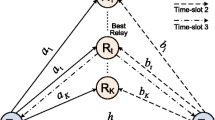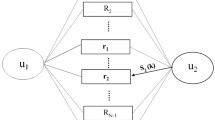Abstract
Most of the works on cooperative systems with or without relay selection have focused on linear modulations such as phase shift keying and quadrature amplitude modulation. Whereas, continuous phase modulation (CPM) is a good alternative to these modulations due to its constant envelope property which enables us to use inexpensive and energy-efficient non-linear power amplifiers. In the literature, a few works are based on relaying systems with CPM. To the best of our knowledge, none exists with relay selection. In this paper, we propose single and multiple relay selection CPM schemes based on a new generalized relay selection criterion for non-orthogonal amplify and forward (AF) systems operating with various time sharing protocols. In particular, using the proposed criterion, the best relay or the best two relays over a set of four available relays is/are selected. Error performances of the non-orthogonal AF relay selection systems and their counterparts are compared over frequency non-selective quasi-static Rayleigh fading channels using Viterbi algorithm at the destination terminal. Our numerical results present superiority of the proposed non-orthogonal relay selection systems.




Similar content being viewed by others
References
Tarokh, V., Seshadri, N., & Calderbank, A. R. (1998). Space–time codes for high data rate wireless communication: Performance criterion and code construction. IEEE Transactions on Information Theory, 44(2), 744–765.
Laneman, J. N., & Wornell, G. W. (2000). Energy efficient antenna sharing and relaying for wireless networks. In Wireless communication and networking conference, Chicago, IL, USA.
Sendonaris, A., Erkip, E., & Aazhang, B. (2003). User cooperation diversity—Part I: System description. IEEE Transactions on Communications, 51(11), 1927–1938.
Laneman, J. N., Tse, D. N. C., & Wornell, G. W. (2004). Cooperative diversity in wireless networks: Efficient protocol and outage behavior. IEEE Transactions on Information Theory, 50(12), 3062–3080.
Laneman, J. N., Wornell, G. W., & Tse, D. N. C. (2001). An efficient protocol for realizing cooperative diversity in wireless networks. In IEEE international symposium on information theory, Washington DC, USA.
Mheidat, H., & Uysal, M. (2006). Impact of receive diversity on the performance of amplify-and-forward relaying under APS and IPS power constraints. IEEE Communications Letters, 10(6), 468–470.
Nosratinia, A., Hunter, T. E., & Hedayat, A. (2004). Cooperative communication in wireless networks. IEEE Communications Magazine, 42(10), 74–80.
Cover, T. M., & El Gamal, A. (1979). Capacity theorems for the relay channel. IEEE Transactions on Information Theory, 25(5), 572–584.
Wu, X., & Xie, L.-L. (2013). On the optimal compressions in the compress-and-forward relay schemes. IEEE Transactions on Information Theory, 59(5), 2613–2628.
Janani, M., Hedayat, A., Hunter, T. E., & Nosratinia, A. (2004). Coded cooperation in wireless communications: Space–time transmission and iterative decoding. IEEE Transactions on Signal Processing, 52(2), 362–371.
Nabar, R. U., Bölcskei, H., & Kneubühler, F. W. (2004). Fading relay channels: Performance limits and space–time signal design. IEEE Journal of Selected Areas in Communications, 22(6), 1099–1109.
Laneman, J. N., & Wornell, G. W. (2003). Distributed space–time coded protocols for exploiting cooperative diversity in wireless networks. IEEE Transactions on Information Theory, 49(10), 2415–2425.
Canpolat, O., Uysal, M., & Fareed, M. M. (2007). Analysis and design of distributed space–time trellis codes with amplify-and-forward relaying. IEEE Transactions on Vehicular Technology, 56(4), 1649–1660.
Krikidis, I., Thompson, J., McLaughlin, S., & Goertz, N. (2008). Optimization issues for cooperative amplify-and-forward systems over block-fading channels. IEEE Transactions on Vehicular Technology, 57(5), 2868–2884.
Azarian, K., El Gamal, H., & Schniter, P. (2005). On the achievable diversity multiplexing tradeoff in half-duplex cooperative channels. IEEE Transactions on Information Theory, 51(12), 4152–4172.
Srinivas, K. V., & Adve, R. (2011). An orthogonal relay protocol with improved diversity-multiplexing tradeoff. IEEE Transactions on Wireless Communications, 10(8), 2412–2416.
Zheng, L., & Tse, D. N. C. (2003). Diversity and multiplexing: A fundamental tradeoff in multiple-antenna channels. IEEE Transactions on Information Theory, 49(5), 1073–1096.
Bletsas, A., Khisti, A., Reed, D., & Lippman, A. (2006). A simple cooperative diversity method based on network path selection. IEEE Journal on Selected Areas in Communications, 24(3), 659–672.
Jing, Y., & Jafarkhani, H. (2009). Single and multiple relay selection schemes and their achievable diversity orders. IEEE Transactions on Wireless Communications, 8(3), 1414–1423.
Zhao, Y., Adve, R., & Lim, T. J. (2006). Symbol error rate of selection amplify-and-forward relay systems. IEEE Communications Letters, 10(11), 757–759.
Krikidis, I., Thompson, J., Mclaughlin, S., & Goertz, N. (2008). Amplify-and-forward with partial relay selection. IEEE Communications Letters, 12(4), 235–237.
Ikki, S. S., & Ahmed, M. H. (2009). On the performance of adaptive decode-and-forward cooperative diversity with the Nth best-relay selection scheme. In IEEE global communications conference, Honolulu, HA, USA.
Ikki, S. S., & Ahmed, M. H. (2009). On the performance of amplify-and-forward cooperative diversity with the Nth best-relay selection scheme. In IEEE international conference on communications, Dresden, Germany.
Chen, L., Carrasco, R. A., & Wassell, I. J. (2011). Opportunistic nonorthogonal amplify-and-forward cooperative communications. IEEE Electronics Letters, 47(10), 626–628.
Chen, L., Carrasco, R. A., & Wassell, I. J. (2012). Cooperative communications with opportunistic nonorthogonal amplify-and-forward relaying. In IEEE 75th vehicular technology conference, Yokohama, Japan.
Proakis, J. G., & Salehi, M. (2008). Digital communications (5th ed.). New York, NY: McGraw-Hill Companies Inc.
Maw, R. L., Martin, P. A., & Taylor, D. P. (2008). Cooperative relaying with CPFSK and distributed space–time trellis codes. IEEE Communications Letters, 12(5), 356–358.
Silvester, A.-M., Lampe, L., & Schober, R. (2008). Distributed space–time continuous phase modulation code design. IEEE Transactions on Wireless Communications, 7(11), 4455–4461.
Yang, Q., & Ho, P. (2011). Cooperative transmission with constant envelope modulations and phase-only forward relays. IEEE Transactions on Wireless Communications, 10(1), 114–123.
Demiroğlu, A. S., Altunbaş, İ., & Çelebi, M. E. (2009). Distributed space–time MSK trellis codes for amplify and forward relaying. In 17th European signal processing conference, Glasgow, Scotland.
Demiroğlu, A. S., Altunbaş, İ., & Çelebi, M. E. (2010). Distributed space–time 4-CPFSK trellis codes for amplify and forward relaying. In 3rd international conference on communication theory, reliability, and quality of service, Athens, Greece.
Demiroğlu, A. S., & Altunbaş, İ. (2013). Distributed space–time trellis codes with continuous phase modulation for amplify and forward relaying. IET Communications, 52(2), 362–371.
Bletsas, A., Shin, H., & Win, M. (2007). Cooperative communications with outage-optimal opportunistic relaying. IEEE Transactions on Wireless Communications, 6(9), 3450–3460.
Alcaraz, J. J., & Garcia-Haro, J. (2009). Performance of single-relay cooperative ARQ retransmission strategies. IEEE Communications Letters, 13(2), 121–123.
Wang, H., Li, M., Lin, J., & Yang, S. (2012). Diversity-multiplexing-delay tradeoff in selection cooperation networks with ARQ. IEEE Transactions on Communications, 60(6), 1729–1740.
Maham, B., Behnad, A., & Debbah, M. (2012). Analysis of outage probability and throughput for half-duplex hybrid-ARQ relay channels. IEEE Transactions on Vehicular Technology, 61(7), 3061–3070.
Xiong, F., & Bhatmuley, S. (1997). Performance of MHPM in Rician and Rayleigh fading mobile channels. IEEE Transactions on Communications, 45(3), 279–283.
Ertaş, T. (2001). Correlation type demodulation of 4-level full-response CPFSK signals (in Turkish). DEÜ Faculty of Engineering—Journal of Science and Engineering, 3(2), 1–12.
Altunbaş, İ. (2005). Space–time trellis codes for MSK. Computers and Electrical Engineering, 31(4–5), 263–271.
Hong, S. K., Chung, J. M., Yun, Y., & Kwon, S. L. (2005). Space–time codes for quaternary CPFSK systems with large number of receiver antennas. AEÜ—International Journal of Electronics and Communication, 59(8), 486–490.
Hong, S. K., & Chung, J. M. (2006). Space–time codes for CPFSK with arbitrary number of receive antennas. IEEE Transactions on Communications, 5(11), 2988–2991.
Author information
Authors and Affiliations
Corresponding author
Appendix
Appendix
This section includes simplifications of (3) for M = 3.
1.1 Protocol A
Since maximization of the last term of the logarithmic expression of (11) determines the optimal selection criterion for Protocol A, (8) is obtained.
1.2 Protocol B
The sum of the last four term of the logarithmic expression of (12) gives (9).
1.3 Protocol C
The last term of the logarithmic expression of (13) gives (10).
Rights and permissions
About this article
Cite this article
Demiroğlu, A.S., Altunbaş, İ. & Çelebi, M.E. Non-orthogonal Amplify and Forward Relay Selection Systems with Distributed Space–Time Trellis Coded Continuous Phase Modulation. Wireless Pers Commun 84, 1209–1225 (2015). https://doi.org/10.1007/s11277-015-2684-8
Published:
Issue Date:
DOI: https://doi.org/10.1007/s11277-015-2684-8




